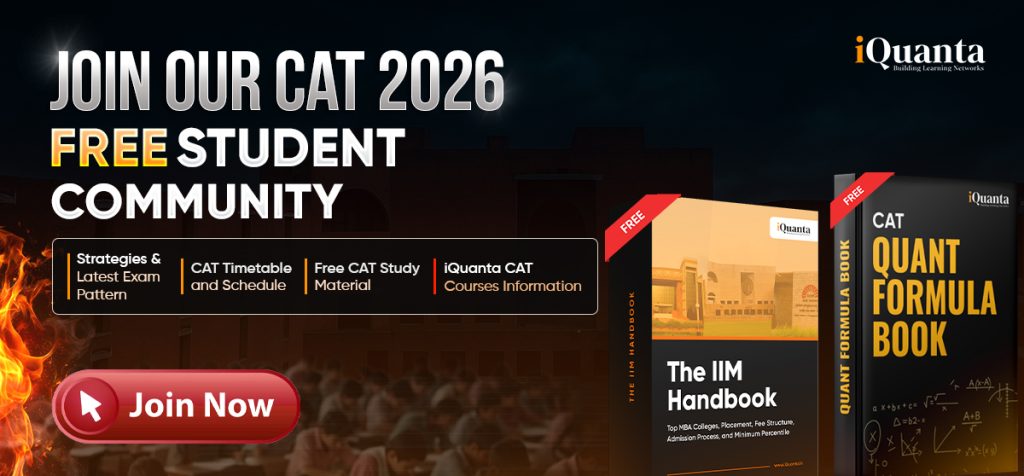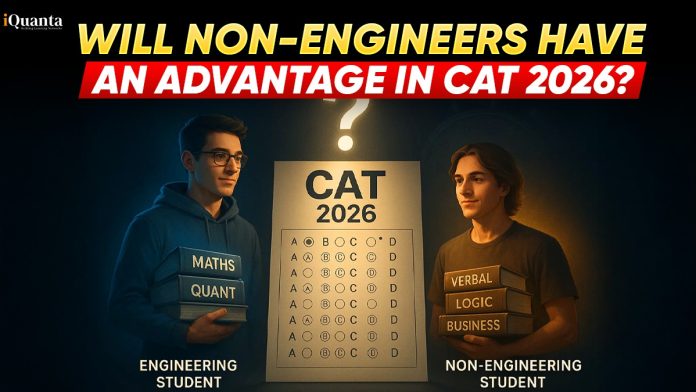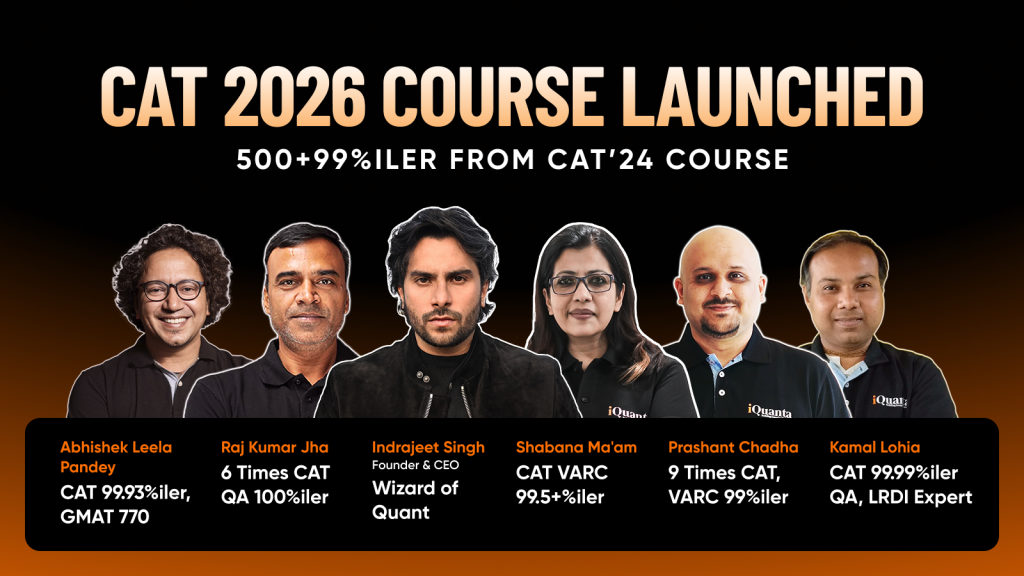CAT 2026 for Non-Engineers: As per the previous year trends, there are many CAT aspirants who are engineering degree holders and due to their mathematics background they holds a good grip in Quantitative Aptitude section in comparison to non-engineers. If we specifically look at CAT last year data, there were around 3.29 lakh CAT aspirants registered for the exam but only 2.93 lakhs candidates appeared for the same. From that almost 70-80% individuals are engineers along with they secure seats in top percentile where out of 14 aspirants, 13 were engineers who were 100%ilers.
However this pattern is slightly shifted in favor of non-engineers due to one of the very important factors that is academic diversity. Top Indian Institutes of Management (IIMs) are supporting academic diversity in their classroom to balance the numbers between engineers and non-engineers which means if non-engineers will score good in both DILR (Data Interpretation & Logical Reasoning) and VARC (Verbal Ability & Reading Comprehension), then they can easily increase their chances to secure seats in IIMs without worry about the engineers vs non-engineers debate. In fact, there are many non-engineers too have managed to secure 99+ percentile in recent years due to their strong reading skills and problem-solving approach towards attempting questions in CAT exam.
In this blog, we will be taking about the advantages for non-engineers by top IIMs, diversity will again benefit non-engineers in CAT 2026 or not, what all different factors are responsible to make CAT 2026 favorable for non-engineers, expected CAT 2026 exam pattern, does VARC and DILR sections again a game changer for non-engineers, QA again be a barrier for them, CAT 2026 preparation strategy for non-engineers and more. So, let’s begin a conversation to deeply understand several factors that will be the advantages for non-engineers in CAT 2026.
Join this free whatsApp group to get the latest information about CAT exam along with the strategies by CAT experts

CAT 2026: Advantages for Non-Engineers by top IIMs!
It is traditionally seen that engineers dominate the CAT exam but the top IIMs have always been a part where they support the balance in academic diversity among engineers and non-engineers. This gradual shift of non-engineers towards the academic diversity by top IIMs creates a sense of confidence and will help them build a CAT 2026 strategy. There are many CAT aspirants who are coming from different academic backgrounds but have unique perspectives towards CAT 2026.
Previous Year CAT exam trends: If we are looking at the CAT 2022 as well as 2023, more non-engineers were breaking the top percentiles which demonstrates the strong CAT 2026 preparation and build CAT 2026 exam confidence to start preparing for that. The strong CAT 2026 preparation strategies for the non-engineers will easily overcome the fear of not performing in the Quantitative Aptitude (QA) section. By focusing on CAT 2026 strategy which covers attempting the mock tests, section tests, consistent practice of QA questions along with keeping confidence across VARC and DILR creates a big impact towards non-engineers and they will easily maximize their scores with the help of this focused approach.
Academic Diversity and Balanced Environment: IIMs are very strict towards their diverse and holistic environment for balancing ratio for both the engineers and non-engineers. This will give an advantage for non-engineers in CAT 2026 apart from preparation and CAT 2026 strategy that they build. With a proper study plan for CAT 2026, time management, problem-solving skills, reading habits will be a game changer for non-engineers to be able to secure seats in the top Indian Institutes of Management. On the one hand, engineers usually dominate the QA section but the smart CAT 2026 strategy and strengths across VARC and DILR sections creates a big change for non-engineers to aim for the top percentiles in CAT 2026.
Also Read – CAT Syllabus 2026
Will Diversity Once Again Benefit Non-Engineers in CAT 2026?
Top Indian Institutes of Management (IIMs) cover strict diversity in their IIM selection process which include gender, academic as well as professional diversity. For the candidates who are non-engineers and covering CAT 2026 strategy across VARC and DILR sections can help them with a great advantage to score good percentile in CAT 2026. So by highlighting these unique factors and skills during the IIM admission process, non-engineers can stand out in such competitive exams in comparison to engineers.
Moreover later there are different CAT 2026 preparation strategies that aspirants adopt to make their chances better in CAT 2026. The CAT 2026 strategy for non-engineers cover sectional tests, covering full-length mock test series, topic-wise practice of questions, focusing on VARC (Verbal Ability & Reading Comprehension) as well as DILR (Data Interpretation and Logical Reasoning). This focused approach later will definitely take non-engineer aspirants to get maximum percentile in CAT 2026. With IIMs valuing academic diversity, gender diversity as well as strong preparation makes it possible for non-engineers to perform in top percentilers in CAT 2026.
Will These Factors Make CAT 2026 Favorable for Non-Engineers?
Academic Diversity and Shortlisting by top IIMs: Top IIMs will always be in favor of creating a balanced approach between engineers and non-engineers in their classroom which increases the trust of both engineers vs non-engineers candidates for the Indian Institutes of Management. The trend of equal opportunities in top IIMs allows non-engineers to stand in confidence during the IIM admission process. They should focus their CAT 2026 preparation plan and highlights journey to strength both the VARC as well as DILR section which again possible through their daily reading habits, analytical skills, problem-solving skills and more.
Exam Patterns Favoring Both DILR & VARC in CAT 2026: In recent years, the CAT (Common Aptitude Test) exam has seen a more balanced weightage across sections DILR, VARC and QA, reducing the Quantitative Aptitude section’s dominance towards the engineering background aspirants. For the non-engineers background aspirants, this is an excellent opportunity to focus more towards CAT 2026 strategy and preparation to maximize their scores during CAT 2026 exam. Strong performance in VARC and DILR section too creates a balance if any non-engineer is not able to score good in the Quants also.
Targeted CAT 2026 Resources to Boost Confidence Towards Top Percentile: There are several resources for CAT 2026 preparation that not only increase confidence among non-engineers but also aim for the top percentilers among non-engineers itself. The resources for the CAT 2026 preparation covers the mock tests, sectional tests, consistent practice question across sections like VARC, QA and DILR. Consistent reading habit will help them balancing their CAT 2026 strategy as well as scores in the CAT 2026 exam. In DILR section, consistent practice of different sets always work which not only helps in building the analytical skills but also the problem solving skills that helps later during the IIM admission process.
CAT 2026 Exam Pattern
This section covers the expected CAT 2026 exam pattern in detail mentioned below.
| Section (s) | Number of Questions (Expected) | Type of Questions | Marks per Question | Time Allotted (per section) | Negative Marking | Difficulty Level (Expected) |
| VARC (Verbal Ability & Reading Comprehension) | 24 | MCQs & TITA (Type In The Answer) | 3 marks | 40 minutes | -1 for wrong MCQ | Moderate |
| DILR (Data Interpretation & Logical Reasoning) | 22 | MCQs & TITA | 3 marks | 40 minutes | -1 for wrong MCQ | Moderate to Difficult |
| QA (Quantitative Ability) | 22 | MCQs & TITA | 3 marks | 40 minutes | -1 for wrong MCQ | Moderate to Difficult |
| Total | 68 | MCQs & TITA | – | 120 minutes | – | Varies per section |
VARC and DILR – Will Both Again Be an Advantage for Non-Engineers in CAT 2026?
VARC and DILR are considered as the two strong pillars for the non-engineers that reflects their diverse background from where they came from. Individuals who are non-engineers usually have subjects which covers the relevancy of reading habits, analytical skills and some sort of areas covers the problem-solving skills too that actually will be a great advantage for non-engineers in CAT 2026 across Verbal Ability & Reading Comprehension as well as DILR (Data Interpretation and Logical Reasoning).
As per the current CAT exam pattern analysis and the expected CAT 2026 exam pattern, it may seem that all the section whether it is VARC, DILR and QA covers the balanced weightage of 24, 22 and 22 question which overall comes to 68. The weightage helps in building CAT 2026 strategy that automatically benefits non-engineers because if they well scores in DILR and VARC with the help of CAT 2026 study plan, then with some sort of consistent practice of questions in QA section will help them all maximize their CAT 2026 scores and take them towards the row for the top percentilers of CAT 2026.
CAT 2026: Will QA again a Barrier for Non-Engineers?
QA section in CAT 2026 may be a fear factor for some non-engineers not for everyone because it is seen that CAT 2026 expected to covers the balanced weightage across DILR, VARC and QA. If they have balanced their complete CAT 2026 strategy for both VARC and DILR, then later with the consistent preparation across arithmetic, algebra and geometry will help them to score better in CAT 2026 and overall it will be an advantage for non-engineers in CAT 2026.
There are some topics according to the high-weightage flow of Quants section that later help non-engineers in CAT 2026 preparation. Check the detailed flow of QA section in the table below where arithmetic and algebra both are non-negotiable.
QA Topics that will Help Non-Engineers in CAT 2026 Preparation
| Main Topic | Important Subtopics |
| Arithmetic | Percentages, Profit & Loss, Simple & Compound Interest, Ratio & Proportion, Time, Speed & Distance, Time & Work, Averages, Mixtures & Alligations |
| Algebra | Linear & Quadratic Equations, Inequalities, Functions, Logarithms, Sequence & Series, Surds & Indices |
| Number System | Divisibility, HCF & LCM, Odd/Even Properties, Prime Numbers, Remainders, Modular Arithmetic |
| Geometry | Lines & Angles, Triangles (Pythagoras, Properties), Circles, Quadrilaterals, Polygons, Coordinate Geometry |
| Mensuration | Areas, Volumes, Surface Areas, Perimeter, 3D Solids (Cylinder, Cone, Sphere) |
| Probability & Permutation & Combination | Basic Probability, Conditional Probability, Counting Principles, Factorials, Permutations, Combinations |
| Modern Math / Miscellaneous | Set Theory, Inequalities, Logarithms, Surds, Complex Numbers, Mixtures & Alligations |
Also Read – CAT Eligibility Criteria 2026
CAT 2026 Preparation Strategy for Non-Engineers
There are some CAT 2026 strategies that will help non-engineers.
- Focus on VARC & DILR strengths that non-engineers usually have to balance the Quant section weightage in CAT 2026 for maximum scores.
- Cover CAT 2026 resources such as sectional mocks, full-length mocks and topic-wise practice as part of a smart CAT 2026 preparation strategy.
- Prioritize time management in CAT 2026 which is considered as one of the most important factors and shortcut techniques to maximize scores in CAT 2026 QA.
Conclusion: CAT 2026 Strategy for Non-Engineers
According to the factors which we have covered in the blog that will be an advantage for non-engineers in CAT 2026 will create an impact and apart from that non-engineers have a real opportunity to excel in CAT 2026 with the help of their balanced strength across VARC and DILR sections along with focused CAT 2026 strategy as well as preparation approach. It is important for the candidates who are coming from the non-engineers background to focus more on the consistent question practice of Quants question and especially with arithmetic and algebra that are not-negotiable, full-length mock tests, sectional tests as well as smart time management can really help non-engineers that score maximum score and be in a top percentilers in CAT 2026.
iQuanta CAT Course 2026
FAQs: Will Non-Engineers Have An Advantage in CAT 2026?
There are two main topics that are non-negotiable for CAT 2026 and helpful for non-engineers to start the Quants CAT 2026 preparation with and those are Arithmetic as well as Algebra.
VARC and DILR are considered as the two strong pillars for the non-engineers that reflects their diverse background from where they came from. Individuals who are non-engineers usually have subjects which covers the relevancy of reading habits, analytical skills and some sort of areas covers the problem-solving skills too that actually will be a great advantage for non-engineers in CAT 2026 across Verbal Ability & Reading Comprehension as well as DILR (Data Interpretation and Logical Reasoning).
There are different CAT 2026 strategies for non-engineers that covers the focus of both VARC and DILR strengths, prioritize time management strategies in CAT 2026 and cover CAT 2026 resources such as sectional mocks, full-length mocks and topic-wise practice as part of a smart CAT 2026 preparation strategy.
There are some important arithmetic topics that are non-negotiable by non-engineers to cover in CAT 2026. This covers Percentages, Profit & Loss, Simple & Compound Interest, Ratio & Proportion, Time, Speed & Distance, Time & Work, Averages, Mixtures & Alligations





